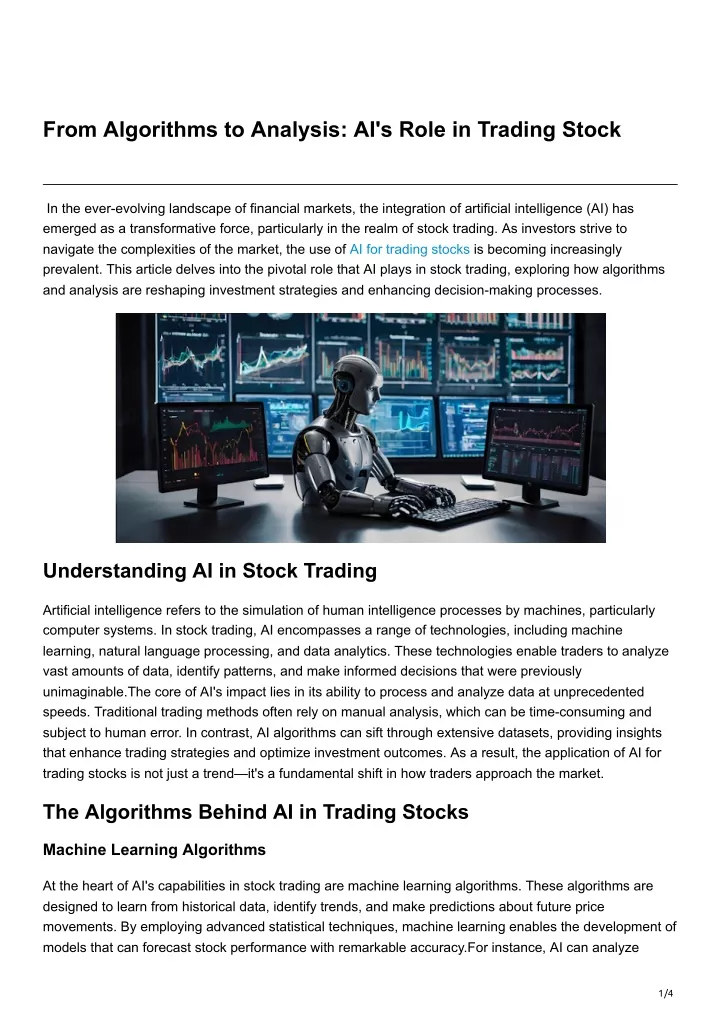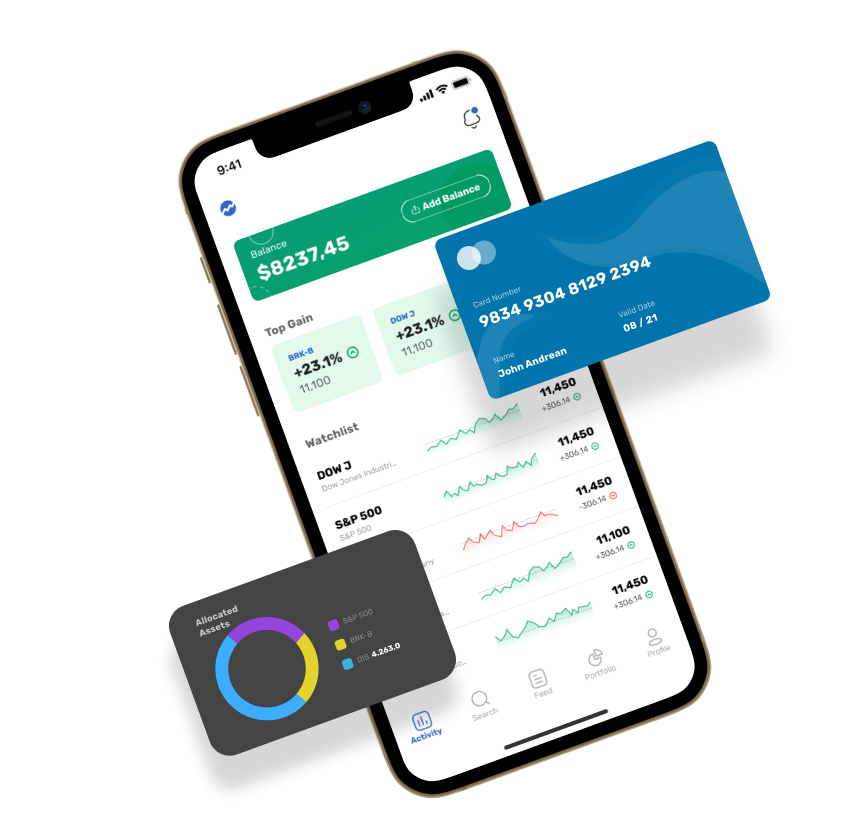Top 10 Suggestions On How To Assess The Strategy Customization Of Ai Trading Platforms
AI stock-predicting/analyzing platforms offer various options for customization, which allow users to modify their platform to meet their own trading goals as well as their risk tolerance and market conditions. A platform with robust customization options can significantly improve the efficiency of your trading. Here are 10 guidelines for evaluating the customizability of the platforms.
1. Evaluate Pre-Built Strategy Templates
The variety of templates available: Find out if the platform offers a range of pre-built strategies for different trading styles (e.g., swing trading, day trading, long-term investment).
Usefulness: Determine the ease with which these templates could be modified to meet your requirements.
Performance history: Check whether the platform has historical performance data on strategies that have been pre-built.
2. Assessment Customized Strategy
Drag-and-drop: Look for platforms that offer drag-and-drop interfaces when creating custom strategies.
Coding Options: If are a skilled user, ensure that the platform can support customized coding.
Flexibility: Ensure that the platform permits you to establish entry and exit rules, risk management parameters, as well as other important elements of your plan.
3. Check for Backtesting Capabilities
Historical data: Verify if the platform provides sufficient historical data to backtest your strategies.
Modifiable parameters: Make sure you have the ability to alter parameters (e.g. timespans, timeframes or indicators) during backtesting.
Performance metrics - Make sure to see if your software offers detailed indicators of performance (e.g. the winning rate, Sharpe coefficient or drawdown) for all strategies that have been backtested.
4. Evaluate Real-Time Strategy Testing
Paper trading: Check if the platform supports simulation and paper trading modes for testing strategies in real-time without taking risks with your capital.
Live testing: Check whether you are able to run strategies on live markets using small amounts of capital to assess their performance.
Real-time adjustments: Check if you can tweak strategies in real-time, based on market conditions.
5. Evaluation of Integration based on Technical Indicators
Indicator library - See whether the platform has an extensive library of technical indicators, including moving averages (e.g. RSI), MACD or RSI.
Custom indicators: Ensure that you have the ability to create or import custom indicators to use in your strategies.
See if you are able to combine several indicators to make more complex strategies.
6. Check for Risk Management Tools
Stop-loss/take-profit: Ensure the platform allows you to set stop-loss and take-profit levels within your strategies.
Position sizing: Check whether you have the ability to establish the rules for sizing your position (e.g. Fixed amount percent of portfolio) to reduce risk.
Risk-reward: Find out if your platform permits you to define risk-rewards for each strategy or trade.
7. Evaluate Multi-Asset Strategy Support
Asset classes: Make sure your platform is able to support different asset classes, such as stocks, ETFs and options.
Strategies for cross-assets : You can try to create strategies involving multiple asset categories (e.g. pair trading, hedges).
Market coverage: Make sure the platform covers the markets you're in (e.g. US and international markets, copyright and so on.).
8. Evaluate Automation and Execution
Automated Trading: Make sure that the platform can implement strategies in a way that is automated based on rules predefined.
Order types - Check that the platform supports a variety of order types that can be used to execute strategies (e.g. stop limit, market or stop).
Latency Check: Ensure that the platform allows for transactions to be completed with minimal latency. This is particularly important when it comes to high-frequency strategy.
9. Check out Strategies Optimization Tools
Parameter optimization: Ensure the platform has tools to optimize strategy parameters (e.g., grid search and genetic algorithms).
Machine Learning Integration: Determine whether a platform incorporates machine-learning to refine and optimize strategy.
Scenario analyses: Verify whether the platform lets you try different strategies in different market scenarios (e.g. bear, bull, volatile).
10. Review User Feedback and Community Support
User reviews: Examine user feedback to gauge the effectiveness of the platform for strategy customization.
Forums for community members: See if you can find forums where members discuss and exchange ideas for custom strategies.
Support resources. Be sure to check for tutorials or webinars to help you create and optimize your strategies.
Bonus Tips
Trial period: Try the features of the platform to customize your experience without cost with a demo or demo.
Scalability: Make sure the platform is able to handle more complicated strategies as your trading evolves.
Support for customers Find out if there is support available for questions or concerns related to strategy.
These tips will help you assess the ability of AI trading platforms to tailor their strategies. You will be able choose the best platform for your needs in trading and allow to you to fine-tune and implement your plan. A platform with flexible options for customization allows you to adapt to changing market circumstances and improve your results. Take a look at the recommended ai investing recommendations for website advice including ai for trading, ai investment app, ai stock trading bot free, ai for trading, stock ai, options ai, ai investing app, ai chart analysis, ai stock trading, best ai stock and more.

Top 10 Tips To Assess The Regulatory Compliance Of Ai Stock Analysis And Prediction Platform
The compliance with regulatory requirements of trading platforms that employ AI to predict/analyze stock prices is an important factor. Compliance assures that a platform complies to financial regulations, and adheres to legal frameworks and safeguarding user data. This lowers the possibility of legal or financial concerns. Here are top 10 tips for evaluating the compliance of these platforms.
1. Check the Licensing and Registration
The regulatory bodies: Make sure the platform is registered and licensed with appropriate financial regulatory bodies (e.g. SEC in U.S.A., FCA UK, ASIC Australia).
Verify the broker relationship If your platform has a partnership with brokers or brokers, be sure they are licensed and regulated.
Public records: You can check the official website of the regulator to find out if the platform is registered and if there have been any violations in the past.
2. Compliance with the Data Privacy Evaluation
GDPR: If your business is located or serving users within the EU Make sure that the platform complies with the General Data Protection Regulation (GDPR).
CCPA: California Consumer Privacy Act compliance is required for all users.
Data handling Policies: Read the policy of the platform's privacy of data to ensure that it outlines exactly how data from users are stored, used and shared.
3. Evaluation of Anti-Money-Laundering Measures
AML Policies: Make sure the platform has AML policies that are strong to stop and detect money laundering.
KYC Procedures: Check if the platform has procedures in place to confirm users' identities.
Monitor transactions: Determine if the platform monitors transactions for suspicious activities and reports it to the appropriate authorities.
4. Verify Compliance of your business with Trading Regulations
Market manipulation: Ensure that the platform is equipped to prevent market manipulation, such as fake trading, wash trading.
Types of orders. Examine if your platform complies with the rules for order types.
Best execution: Make sure the platform is in line with the highest standards of execution, and ensures that trades are executed at most competitive price.
5. Cybersecurity Assessment
Data encryption: Ensure that the platform is encrypted to safeguard user data in transit and in rest.
Incident response: Verify if the platform has a clearly defined incident response plan for data breaches or cyberattacks.
Certifications: Make sure the platform has cybersecurity certifications.
6. Examine Transparency and Transparency
Fee disclosure: Make sure that the platform clearly discloses all fees including additional charges or hidden charges.
Risk disclosure: Ensure that the platform is transparent about all risks, especially when you use high-risk strategies or trading using leverage.
Performance reporting: Determine if the AI platform's models are transparently and properly recorded.
7. Verify that you are in the compliance of international regulations
Trading across borders If you're trading internationally, ensure that the platform is compliant with all regulations.
Tax reporting: Find out whether the platform has tools or reports that help users adhere to tax regulations.
Conformity with sanctions: Ensure whether the platform is in compliance with international sanctions and doesn't allow trading with entities or countries prohibited.
8. Assess record-keeping and audit trails
Records of transactions: The platform needs to keep detailed records of the transactions that are used for regulatory and auditor reasons.
Logs of user activity - Check that the platform records all user activity including logins to the platform, trades executed and any modifications to account settings.
Audit readiness: Determine whether your platform is able to provide the required logs and documentation in the case of an inspection by a regulatory agency.
9. Evaluation of Compliance with AI Specific Regulations
Algorithmic trading regulations: If the platform is able to support algorithmic trading, be sure that it complies with regulations like MiFID II in Europe or Reg SCI in the U.S.
Fairness and impartiality: Check whether the platform's AI models are monitored and adjusted to ensure that they are not biased.
Explainability. Certain regulations could require that the platform describe AI-driven predictions and decisions.
10. Review User Comments and Historical Regulatory The History
User feedback: Review reviews from users to determine the platform’s reputation for regulatory conformity.
The history of regulation: Check for violations in the past of regulations and penalties, fines or sanctions.
Third-party auditors: Check if the platform is audited regularly by third parties to make sure it is adhering to rules and regulations.
Bonus Tips:
Legal consultation: Talk to a lawyer to ensure the platform complies with the relevant laws.
Trial period for free: You may make use of a demo or a no-cost trial to try out the compliance features of the platform and its documentation.
Support for customers: Ensure that the platform provides support to answer questions or concerns that concern compliance.
With these suggestions, you can effectively assess the regulatory compliance of AI stock predicting/analyzing trading platforms and ensure that you select a platform that operates within legal frameworks and protects your rights. The compliance not only reduces the legal risk but also increases confidence in the service of a platform. Have a look at the recommended ai software stocks tips for website info including trading ai tool, best ai trading platform, best ai stock prediction, stock predictor, best ai stock prediction, ai in stock market, best ai stocks, investing with ai, ai options trading, ai stock analysis and more.

Comments on “20 Great Facts For Choosing AI Stock Predictions Platform Sites”